
发布时间:2022-08-19
导语:
本篇带您了解回味瑞士20年前举办的一场著名的国家博览会(Expo' 02)。这是瑞士最近的一届国家级博览会,于2002年分别在纳沙泰尔(Neuchâtel)、伊韦尔东(Yverdon-les-Bains)、穆尔藤(Murten)、比尔(Biel/Bienne)四座城市举办。
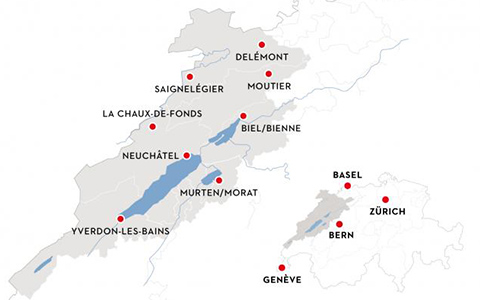
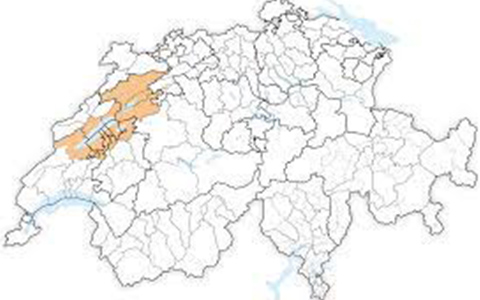
瑞士传统上每隔25年左右会举办一次全国性的博览会,在国家层面进行一次政治、社会、人口方面的评估。博览会旨在向人们展示瑞士整个国家的现状以及它的目标。
前几届博览会分别在苏黎世(1883年)、日内瓦(1896年)、伯尔尼(1914年)、苏黎世(1939年)和洛桑(1964年)等地举行。1896年、1914年和1939年的三届博览会都凸显了瑞士军队主题,反映了瑞士展示其国家独立性的愿望。1939年的博览会尤为突出这一主题,它主要是瑞士当时普遍奉行的“在精神上保卫国家”这一政策的产物。
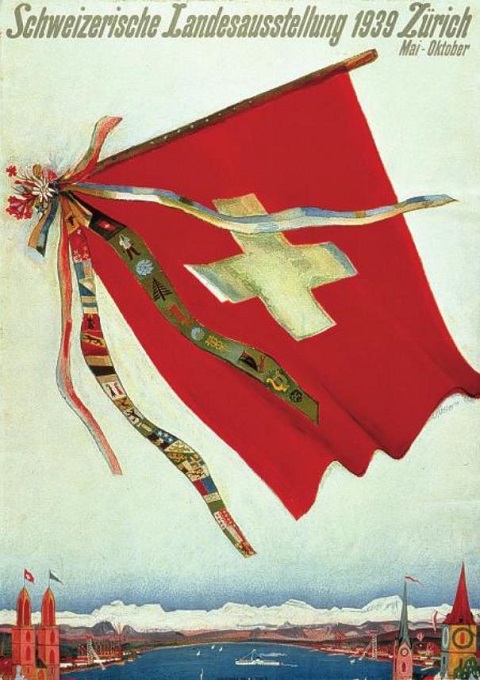
而1964年在洛桑举办的国家博览会则展示了瑞士一派充满未来主义色彩的景象。博览会上展示的内容主要包括未来的交通方式和“明日之家”,对洗碗机等便利居家产品进行了展示,反映了居家妈妈们日常生活品质的提升。
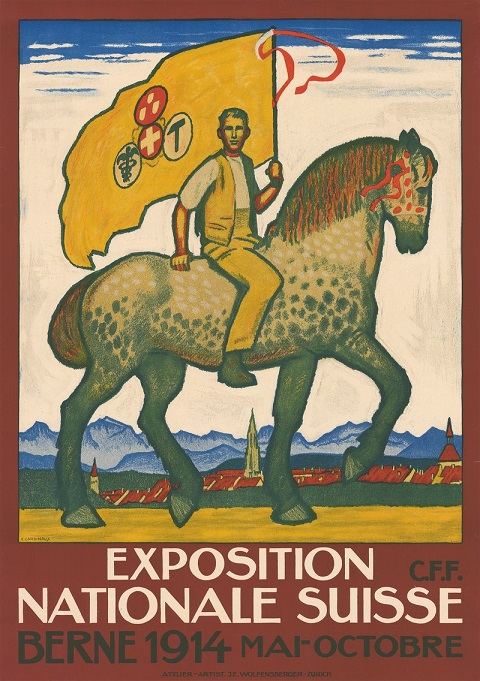
1964年举办的博览会正处于冷战的白热化阶段,展会显示了瑞士的价值观,而2002年的博览会则力图展现瑞士的一片未来主义景象,并宣传瑞士是一个开放、前瞻性和注重环保的国家,主题是水和瑞士对确保海外和平的承诺。
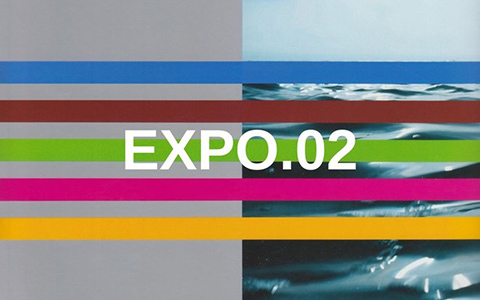
02年国家博览会(Expo ’20)
早在90年代初,许多政界人士就在担心瑞士的"Röstigraben"现象,这个词表示瑞士德语区和法语区之间存在的文化分离。为了使国家再次团结起来,一些人建议举办全国性的博览会,因为于1964年在洛桑举办的上一届博览会大获成功。因此,为庆祝千禧年的到来,有关部门决定举办新的一届全国博览会。

为了体现瑞士的多样性(这是瑞士的一大特色),这一届国家博览会分别在瑞士西部三湖地区(纳沙泰尔湖、比尔湖、穆尔藤湖)的几座城市举办:
- 伊韦尔东(法语区)
- 纳沙泰尔(法语区)
- 穆尔藤(德语区)
- 比尔(德-法双语区)
此外,还有一艘在湖上巡游各处的游船,代表了没有任何湖泊的汝拉州(法语区)。
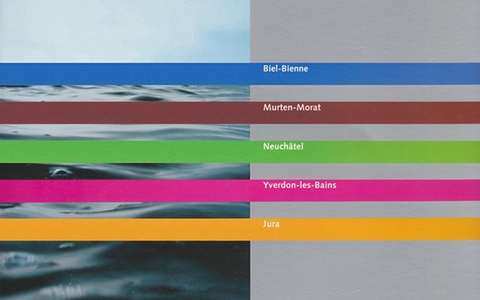
该项目的最早发起人之一,也是纳沙泰尔的一位著名建筑师,提出了以ArtePlages一词命名的概念。这个词由 "art "和 "plages"(艺术和沙滩)两个词缩略组合而成,这意味着展览区域划定在了湖岸边。搭建的一个个ArtePlages艺术沙滩展台将在活动结束时被完全拆除,从而可以快速腾出空间,而无需经过漫长的行政手续。每个艺术沙滩展台都有自己的主题,包含许多家展馆和各种动画特效。在2002年博览会期间,最终共举办了139场展览。
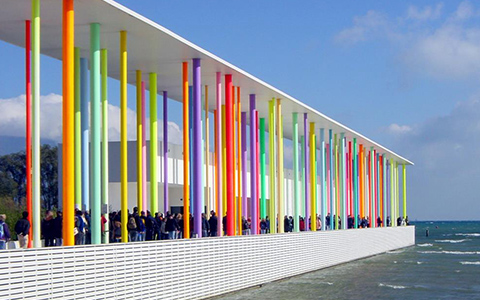
艺术沙滩展区和主题
1. 纳沙泰尔:自然与人工
在纳沙泰尔艺术沙滩展区(Arteplage Neuchâtel),一切都围绕着自然和人工展开:高科技让自然与人工诗意地融合。我们依赖环境,并根据我们的需求来构造它。在这里,身体与精神、科学与虚构融为一体。
公众对艺术沙滩展区表现出了极大的兴趣和好奇心,这意味着这里的展区建筑奇观大获成功。在2002年纳沙泰尔举办的博览会上,艺术沙滩展区举办的展览将参观者带入到了未来技术和人工世界。
一座有着未来主义外观的半岛形似三只大型飞碟。它们应该是代表鹅卵石;这是瑞士海滩的象征。数百支闪亮的塑料芦苇环绕在周围,发出幽幽的绿光。
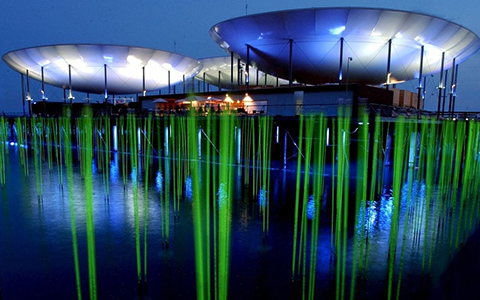
以下是对纳沙泰尔的几场主要展览的介绍:
生物之城(Biopolis)
这个建筑是"生物之城"展的所在地,这里有一座未来的城市,让人们一睹现代生物研究成为现实的场景。在这里,参观者能够看到一些由最新的生物技术研究成果制成的新产品。
参观者还进入到了一个机器人的世界,在这里,人和机器已经成为一体。它向我们提出了一个问题,即人类在未来是否会与这种高科技共同生活,以及自然和人工之间的界限是否会完全消融。

12级风暴(Beaufort 12)
这是一个有趣的展览,它展现了一场灾难,大自然的原始力量以飓风的形式被释放出来。参观者可以进入一个模拟器,感受巨大风力的袭击。
Beaufort 12是指飓风的风力等级。这种等级的风暴不仅具有极大的破坏力,而且还会给人们带来巨大的悲痛。那些被自然灾害侵袭过后的物品,以及受害者的照片和采访,都见证了大自然的力量。展览现场开放了一处人工景观,它模拟的是纳沙泰尔艺术沙滩展区(Neuchâtel Arteplage)正在被一场灾难吞噬时的情景,其中有泥石流、雪崩、火灾和风。现场还有一台风暴模拟器,让你亲身感受到强风吹袭皮肤的感觉。
最后值得一提的是,景观模型中的紧急避难所展示了如何通过团结、预防和技术将风险降到最低。
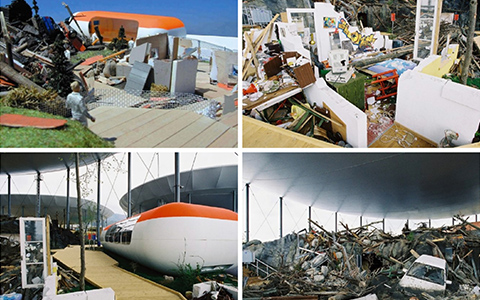
平衡之殿(Palace of Equilibrium)
在一个离地面27米高的木制球体中有一座平衡之殿,这一展览是为了提高人们对环境问题和可持续发展的认识。
展出的内容还包括对地球的航拍照片、关于可持续发展的全球先决条件的评论以及关于迄今所取得的成就的报告。早在2002年就传达了这样的信息:“可持续发展不是一件可以委托他人的事情,它需要我们每一个人在日常生活中进行规划和行动“。
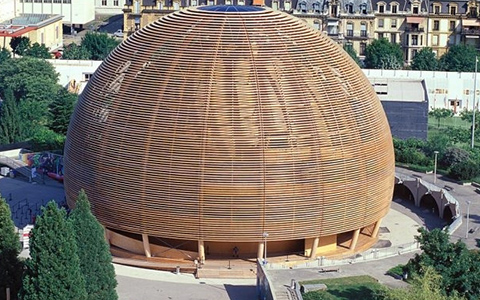
天赐食粮(Manna)
“天赐食粮(Manna)”展览的目的是质疑人们的消费习惯,并引人思考:在我们的饮食中什么是自然的、什么是人工的。展示内容包括多种香氛和香料,以提高人们对人工芳香剂的认识。
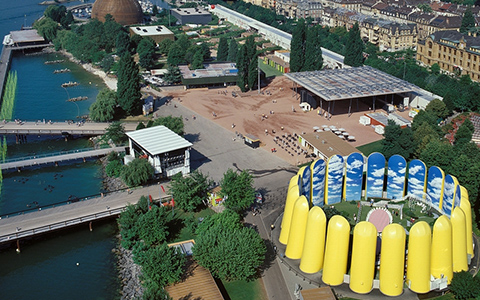
2. 伊韦尔东:我与宇宙
色彩丰富的伊韦尔东艺术沙滩展区被打造成柔软、圆形、感性的形态,仿佛被鲜花和合成材料覆盖的一座座山丘:它被称为感官花园。这里的主题是“我与宇宙”,它探究的是人与周围世界的互动。
六座山丘(Six Hills)
山丘的景观被设计成一个不断绽放和散发香味的花海。季节性的花朵依次绽放,纷繁灿烂。参观者可以在园区里游览一座座布满鲜花的山丘。展区内布局温和纤巧,让参观者沉浸在一个由灯光、花与色彩交织的世界里。

云朵(The Cloud)
伊韦尔东的主要景点是纳沙泰尔湖面上方悬挂着的一片云层。在31,140个喷射器和80台泵的作用下,湖面上形成了一层雾气,仿佛一大片云朵漂浮在空中。人们在金属走道上行走,同时也置身于云雾缭绕之中。
伊韦尔东的艺术沙滩展区通过这些概念,将色调、香味、图像一一展现,令人不禁想要去触摸、去闻、去品尝和观察,从而鼓励参观者发现或更好地感知自己认识和感受中的世界。
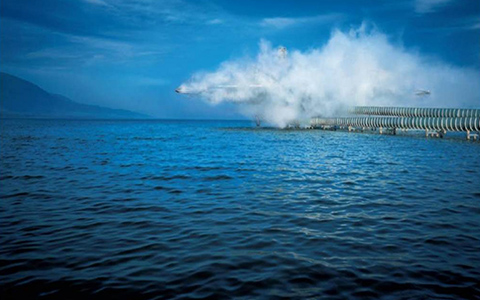
3. 比尔:权力与自由
比尔艺术沙滩展区主要围绕“权力与自由”这一主题展开。设计师们采用建筑和景观设计对这一主题进行了诠释:比尔艺术沙滩展区采用象征着权力的刚性建筑,与位于湖岸的植物和有机公园形成了鲜明的对比。
天堂里的陌生人(Strangers in Paradise)
众多展览中,有一项展览名为“天堂里的陌生人”,它展示了瑞士极为丰富的文化和社会多样性。这趟轻松愉悦之旅带领参观者一览瑞士社会的方方面面,在参观者心中树立起他们所理解的瑞士形象。
在这个展览中,参观者可坐在系统控制的购物手推车里,用11分钟的时间游览一栋三层楼的建筑。该展览邀请参观者以孩子般开放和游戏的心态来体验瑞士,就像让你坐在购物手推车里,穿过一个购物天堂。
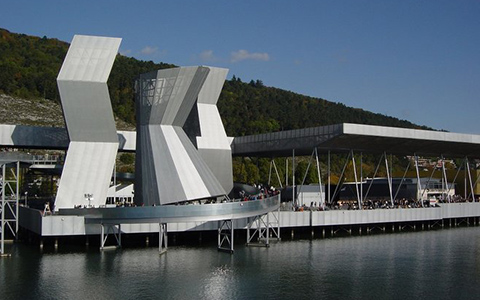
货币与价值(Money and Value)
另一个著名的展览内容是一台毁钞机。在博览会期间,这台机器让参观者看到了两三千万瑞郎被切成碎片的过程。博览会想要展示的是金钱毫无价值的一面,同时强调那些价值不可估量的宝藏。
这一做法受到了一些参观者的强烈批评,因为许多人并不知道这一展览背后传达了什么信息。
4. 穆尔藤:瞬间与永恒
中世纪的穆尔藤镇本身就被改造成了艺术沙滩展区。但对许多参观者而言,穆尔藤的一块巨石——浮在镇外湖面上的一块生锈的立方体,是02年博览会的亮点之一。这个生锈的立方体象征着过去,其巨大的尺寸和雄伟的外壁表明,过去不容易被遗忘。
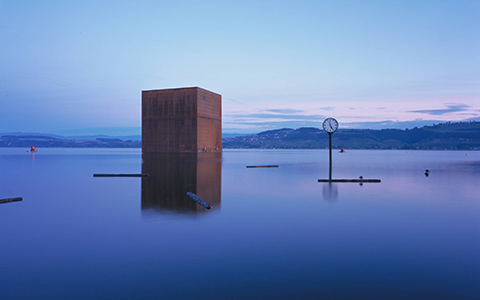
巨石(Monolith)
为什么要谈论过去?巨石上有一个360度全景图,展示了1476年勃艮第(今天的法国)公爵和伯尔尼(今天的瑞士)联盟者之间的穆尔藤之战。这个展览反映的是“昨日的瑞士”,赋予了穆尔藤镇历史意义。
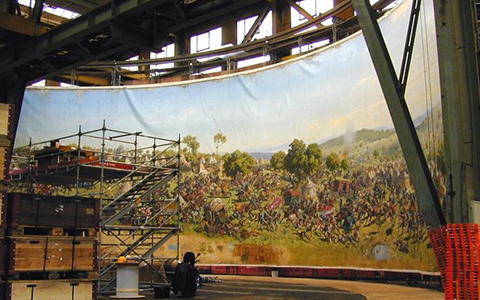
另一方面,在这个生锈的立方体中还有第二幅全景图,展现了人们对现代瑞士的憧憬。
展出的一幅幅以创新为主题的图片既展示了瑞士老生常谈的一面,也从完全新颖的角度展现了这个国家。全景图的目的是鼓励参观者对以往的视角提出质疑,从而创造一个符合当下的、个性化的瑞士形象。
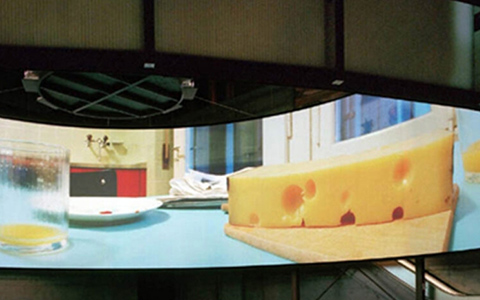
5. 汝拉:意义与运动
汝拉艺术沙滩展区与其他任何展区都不同。其他艺术沙滩展区是被刻意安置在湖岸边的,而汝拉展区实际上则是由一艘运输碎石的船重新改装而成。这条船最引人注目的一点是,它会穿过连接穆尔藤、比尔和纳沙泰尔三个湖的运河,从一个艺术沙滩展区驶向另一个艺术沙滩展区。
海盗船(Pirate Ship)
这艘现代三桅帆船自由地从一个艺术沙滩展区游弋到另一个艺术沙滩展区,并且不断地变幻外观。船上的活动和展览同样是变幻莫测,每次都是一场盛会。作为一艘海盗船,汝拉的移动艺术沙滩展区充分体现了移动一词的意义:它变幻无常且独立自主,让富有冒险精神的乘客在一段时空和想象世界里作短暂的停留。而这些正是汝拉州本身的特色。
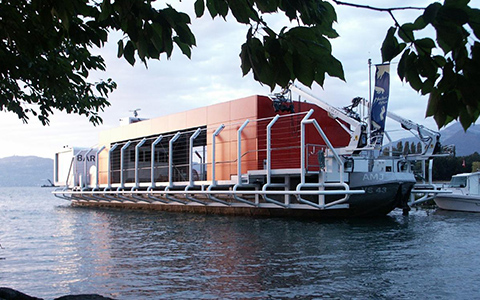
6. 纳沙泰尔的展览还剩下什么
这项展览受到批评的一个主要问题是它的可持性的延续;它几乎没有留下任何可以看到的东西。零星几处纪念馆仍然被保留下来,用于其他目的。例如,纳沙泰尔艺术沙滩展区的木结构球体建筑被日内瓦的欧洲核子研究理事会(CERN)买下。
02年博览会的另一个遗留物是至今仍在使用的纳沙泰尔帕拉菲特(Palafitte)酒店。酒店建于2002年,是瑞士02年国家博览会的一部分。它是著名建筑师库尔特·霍夫曼(Kurt Hofmann)和洛桑酒店管理学院(EHL)的学生合作的成果。该酒店是瑞士国家展览的一大地标建筑物。
酒店原本计划拆除,但由于建筑品质高,它已经持续使用了20多年。该酒店的一个特殊和独特之处在于,它也遵循了艺术沙滩的主题,因为它是欧洲唯一一家建在水上的酒店。
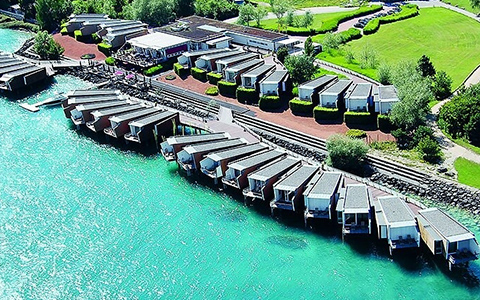
历时5个月后,这一届别具一格的盛会圆满结束。2002年国家博览会被视为一届成功的博览会,因为它能够结合瑞士的三项资产:瑞士的风景、建筑和创新人才,以及民众的热情,正是这三者让瑞士如此丰富多彩。总的来说,每两个瑞士人中就有一人参观了这一届博览会,而且平均反复参观了2.4次。2002年博览会拥有超过1000万件展品,比1998年里斯本的世界博览会还多。
这一届博览会还推动了当地经济的发展,并使主办城市的面貌焕然一新。博览会付出的巨大努力、激动人心的建筑和 “神奇的时刻”都给420万参观者留下了深刻的印象。
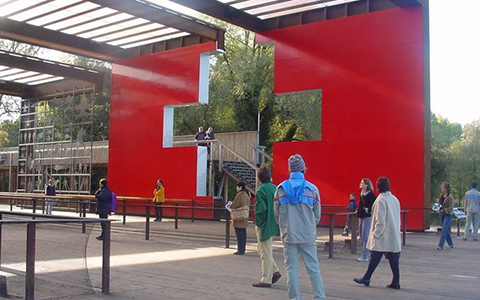
然而,并不是每个人都对博览会如此热心。一些人质疑它的目的是什么,它试图传达什么信息。此外,博览会固然令人激动,但它背后还背负着项目成本。项目总成本最初估计为14亿瑞郎,议会不得不数次投票要求增加资金。在最后确定的16亿瑞郎中,联邦支付了9.3亿瑞郎,各城市和各州支付了8500万瑞郎,其余的来自私人资金。
对于公众来说,参观02年博览会也给钱包造成了沉重的负担:门票、停车费、纪念品和接驳班车有时被认为太贵。
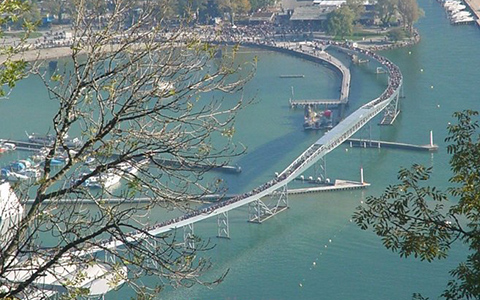
值此02年博览会20周年之际,我们有机会再次追忆这一盛会。2027年,瑞士将再次举办国家博览会,这将给瑞士提供一个理想的框架,去思考并积极塑造它的未来。让我们拭目以待,看看瑞士下一届国家博览会的模样和它将要呈现给我们的精彩。
Original English Text
Expo ’02 – 20 years on
A. Introduction
This article looks back on the famous national exposition which took place 20 years ago and was called Expo ’02. It was the last Swiss national exposition and was held in 2002 in the cities of Neuchâtel, Yverdon-les-Bains, Murten, Biel/Bienne.
It is traditional in Switzerland to make a, political, social, demographical, assessment of the country every 25 years or so by means of a national exhibition. The purpose of these expositions is to show the people where Switzerland as a country is and where it aims to be at.
The previous expositions were held in Zurich in 1883, Geneva in 1896, Bern in 1914, Zurich in 1939, and Lausanne in 1964. During the 1896, 1914 and 1939 exhibitions, the Swiss army theme dominated the three events reflecting a desire by the country to demonstrate its independence. The event of 1939, in particular, was largely the product of the prevailing "spiritual defense of the nation" policy of Switzerland.
The 1964 national exhibition in Lausanne however presented a futuristic vision of the country. It mainly showcased future modes of transport and the improvement of daily living for stay-at-home mothers which was called the "house of tomorrow" where products such as dishwashers became were presented.
Held at the height of the Cold War, the 1964 edition showcased Swiss values whilst the 2002 exposition sought to give a futuristic glimpse of Switzerland and promote the country as an open and forward-looking nation with a concern for its environmental integrity. Its main theme was water and Switzerland's commitment to securing peace abroad.
B. Expo ’02
Back in the early ‘90s, many of the political class feared what we call in Switzerland the "Röstigraben", a word defining the cultural separation that exists between the German and French speaking parts of Switzerland. Therefore, in an effort to unite the country again, some suggested a national exposition since the last one which took place in Lausanne in 1964 had been a major success. Therefore it was decided to organise a new national exhibition to celebrate the turn of the millennial.
To illustrate the diversity of Switzerland which is its key attribute, the national exhibition was spread over different cities:
- Yverdon-les-Bains (French speaking)
- Neuchâtel (French speaking)
- Murten (German speaking)
- Biel (Bilingual German-French speaking)
A mobile boat on the lakes that was travelling from one location to the other represented the canton of Jura (French speaking) which does not have any lakes.
An idea by one of the very first initiators of the project, who was a famous architects of Neuchâtel, introduced the name of ArtePlages. This contraction between "art" and "plages" (art and beaches) designates the areas for exhibitions on the shore of the lake. These structures would be completely dismantled at the end of the event which made it possible to create spaces quickly without having to face long procedures of public inquiry. Each arteplage was created with its own theme and offered numerous pavilions and animations. In total, 139 exhibitions were eventually presented during Expo ’02.
C. Arteplages and Themes
1. Neuchâtel – Nature and Artificiality
On the Arteplage Neuchâtel, everything revolves around nature and artificiality: high-tech poetry lets nature merge with artificialness. We are dependent on our environment, and we structure it according to our needs. Here, body and spirit, science and fiction, are merged into one.
The curiosity and the interest of the public meant that these architectural wonders were a great success. The exhibitions displayed at the Expo ’02 arteplages in Neuchâtel transported the visitors into the technological future and its artificialness.
The futuristic looking peninsula gave the impression of three big flying saucers. These structures were supposed to represent pebbles; an Icon of the Swiss beaches. The green lights actually were hundreds of shining plastic reeds surrounding the structure.
Below you will find a descriptions of the main exhibitions located in Neuchâtel.
Biopolis
This construction housed the “Biopolis” exposition In it was the city of the future as it offered a glimpse of the future where modern biological research would become a reality. Visitors were able to discover the new products that would be available in the future thanks to the latest biological research.
People were also exposed to the world of robotics where man and machine had become one. It posed the question whether man would live together with this high technology in the future and whether the boundary between natural and artificial would completely dissolve.
Beaufort 12
An interesting exhibit was a disaster scenario where the raw power of nature was unleashed in the form of a hurricane. Visitors could enter a simulator and be assaulted by immense winds.
Beaufort 12 designated the wind force of a hurricane. A storm of this severity not only causes immense damage, it also inflicts great suffering and grief. Objects found in the wake of natural disasters as well as pictures and interviews with victims testify to the power of nature. An artificially created landscape would open up as if Neuchâtel Arteplage was being engulfed by a disaster, with mud slides, avalanches, fire and wind. A storm simulator let you feel on your own skin what it’s like to be hit by a gale-force wind.
Last but not least, an emergency shelter under the model landscape showed how risks can be minimized – by solidarity, prevention and technology.
Palace of Equilibrium
Housed in a wooden sphere towering 27 meters above the ground, the palace of equilibrium was showcased to raise awareness concerning environmental matters and sustainable development.
Aerial photographs of our planet, commentaries on the global prerequisites for sustainable development and reports on what had been achieved so far were also presented. The message already back in 2002 was: "sustainability is not something that can be delegated; it requires planning and action by each and every one of us in our daily lives".
Manna
The goal of the "Manna" exhibit was to question people their consumption habits and think about what is natural and artificial in our diet. Multiple aromas and fragrances were showcased to raise awareness about the artificial production of aromas.
2. Yverdon – Me and the Universe
The colorful Yverdon-les-Bains arteplage featured soft, round, sensual shapes, like hills covered with flowers and synthetic materials: it was called the Garden of the Senses. The theme in this location was “Me and the universe” and it investigated the interaction between humans and the world around them.
Six Hills
The hill-range landscape was designed to be a constantly blooming and scented sea of flowers. The seasonal flowers bloomed in succession and produced a glorious show. Visitors could explore the park visiting the hills fully decorated with flowers. The gentle, fragile interior of the forum offered the visitor a real explosion of lights, materials and colours.
The Cloud
The main attraction in Yverdon was the cloud which was hanging above the waters of lake Neuchâtel. With 31,140 jets and 80 pumps which created a kind of fog on the lake, it seemed as though the cloud was floating in the air. People could walk on the metal walkway and in the cloud itself.
By means of these conceptions where hues, fragrances, images, and urges to touch, smell, taste and observe where exhibited, the arteplage of Yverdon was created to encourage visitors to discover or better perceive the world of their ideas and feelings.
3. Biel – Power and Freedom
The Biel arteplage's major focus was on the theme "Power and Freedom". The way designers interpreted the theme on the architectural and landscape design levels was the rigidly constructed arteplage Biel-Bienne as symbols of power in contrast to the vegetal and organic park situated at the shore of the lake.
Strangers in Paradise
One of the expositions was Strangers in Paradise and showed how great the cultural and social diversity of Switzerland is. On the entertaining ride through an imaginary Switzerland, visitors could imagine their personal image of Switzerland.
In this attraction, visitors sat in system-controlled shopping trolleys and glided through a three-story building for eleven minutes. The exhibition invited visitors to experience Switzerland with the openness and playfulness of a child. Just like when you sat in your shopping trolley and the consumer paradise passed you by.
Money and Value
Another famous exhibition was the money-destroying machine which cut twenty to thirty million francs to shreds for all to see during the course of the Expo. What the exposition wanted to show was money from its worthless side and at the same time highlight those treasures whose value is immeasurable.
This was heavily criticized by certain visitors as many did not know what the message was behind these exhibitions.
4. Murten – Instant and Eternity
The medieval town of Murten was in itself transformed into arteplage. But for many visitors however, its Monolith, a rusty cube that floated on the lake off of the town, was one of the highlights of Expo.02. Accessible by boat the rusty cube was a symbol of the past, and its sheer size and imposing facades demonstrated that the past cannot easily be forgotten.
Monolith
Why speak about the past? The Monolith contained a 360-degree panorama of the Battle of Murten, a battle in 1476 between the Duke of Burgundy (today’s France) and the Confederates of Bern (today’s Switzerland). This exposition was a reflection of “yesterday's Switzerland” which gave the town its historic significance.
On the other hand, a second panorama contained in the rusty cube presented a panorama visioning a modern-day Switzerland.
The images on the theme of creation show Switzerland both with its clichés and from completely unexpected perspectives. The panorama intended to encourage visitors to create a current, personal image of Switzerland and to question their previous perceptions.
5. Jura – Meaning and Motion
The Jura arteplage was unlike any other. Instead of being attached on the shore like the other arteplages, it actually was a reconverted boat that was used to transport gravel. What stood out the most about this boat was that it would travel from on arteplage to another passing through the canals that link the three lakes of Murten, Biel and Neuchâtel.
Pirate Ship
The modern barque cruised freely from one arteplage to another and constantly changed. The events and exhibitions on board were also characterized by unpredictability making it an event every time. As a pirate ship, the mobile arteplage of Jura was mobile in every sense of the word: it was changeable and independent, offering adventurous passengers a brief stay in space, time and their imagination. These are the very characteristics that define the canton of Jura itself.
6. What is left of the Exhibition in Neuchâtel
One of the main issues with the exhibition for which it was criticised, was its sustainable continuation; almost nothing of it is left anywhere to be seen. A few monuments here and there have still been kept and have been used for other purposes. For example, the wooden sphere at the Neuchâtel arteplage was bought by the CERN which is the European Council for Nuclear Research in Geneva.
Another remaining survivor of Expo. 02 which still is in use to this day is the Palafitte Hotel in Neuchâtel. It was built back in 2002 as part of the Swiss national exhibition Expo.02. It is the result of a collaboration between renowned architect Kurt Hofmann and students from the hotel management school EHL in Lausanne. The hotel is one of the last landmarks of the Swiss national exhibition.
It was originally supposed to be dismantled but thanks to the quality of the construction it has lasted over 20 years. A special and unique feature about this Hotel is that it also followed the theme of arteplages as it is the only Hotel in Europe that is built on water.
Conslusion:
After 5 months, this unique event came to an end. Expo.02 was dubbed a success because it was able to combine three of the assets that make Switzerland so rich: its landscapes, its architectural and creative talents, and the popular enthusiasm. In total, one out of two Swiss visited the exhibition and on average returned 2.4 times. Expo.02 boasted more than 10 million entries, more than the 1998 Universal Fair in Lisbon.
It also gave a boost to the local economy and a fresh look to the host towns. The 4.2 million visitors remember the tremendous amount of effort, the exciting architecture and the "magic of the moment".
However, not everyone was as enthusiastic about the exposition. Some people questioned what the purpose of it was and what message it was trying to convey. Also overshadowing the excitement of the exhibition was the total cost of the project. Initially estimated at 1.4 billion francs, the Parliament had to vote several times for additional funds. Of the resulting 1.6 billion francs, the Confederation paid 930 million francs, the cities and cantons 85 million francs, and the rest came from private funds.
For the public, too, a visit to Expo ’02 weighed heavily on the wallet: entrance fees, parking, souvenirs and shuttle buses were sometimes considered too expensive.
The 20th anniversary of Expo ’02 gave the people the opportunity to reminisce on that special event. In 2027, Switzerland will once again host a national exhibition which gives the country the ideal framework to reflect on its future and actively shape it. We at La Soleille Family Office are excited and looking forward to see what that National Exposition will look like and what it has to offer.
本文转载自雷梭勒家族办公室,如有侵权,敬请告知删除。
Sooswiss为您提供
瑞士方向私人管家式的定制服务:
1)家族传承 2)财富管理 3)瑞士投资
4)居留计划 5)税务优化 6)家族治理
更多资讯请登录网站 www.sooswiss.com
